Secretion of cryptococcal phospholipase B1 (PLB1) is regulated by a glycosylphosphatidylinositol (GPI) anchor
- PMID: 15826239
- PMCID: PMC1180731
- DOI: 10.1042/BJ20050063
Secretion of cryptococcal phospholipase B1 (PLB1) is regulated by a glycosylphosphatidylinositol (GPI) anchor
Abstract
The secreted, multifunctional enzyme PLB1 (phospholipase B1 protein encoded by the PLB1 gene) is a virulence determinant of the pathogenic fungus Cryptococcus neoformans, but the mechanism of its secretion is unknown. The cryptococcal PLB1 gene encodes putative, N-terminal LP (leader peptide) and C-terminal GPI (glycosylphosphatidylinositol) anchor attachment motifs, suggesting that PLB1 is GPI-anchored before secretion. To investigate the role of these motifs in PLB1 secretion, four cDNA constructs were created encoding the full-length construct (PLB1) and three truncated versions without the LP and/or the GPI anchor attachment motifs [(LP-)PLB1 (PLB1 expressed without the LP consensus motif), (LP-)PLB1(GPI-) (PLB1 expressed without the LP and GPI consensus motifs) and PLB1(GPI-) (PLB1 expressed without the GPI anchor attachment motif) respectively]. The constructs were ligated into pYES2, and galactose-induced expression was achieved in Saccharomyces cerevisiae. The LP was essential for secretion of the PLB1 protein and its three activities (PLB, lysophospholipase and lysophospholipase transacylase). Deletion of the GPI motif to create PLB1(GPI-) resulted in a redistribution of activity from the cell wall and membranes to the secreted and cytosolic fractions, with 36-54% of the total activity being secreted as compared with <5% for PLB1. PLB1 produced the maximum cell-associated activity (>2-fold more than that for PLB1(GPI-)), with 75-86% of this in the cell-wall fraction, 6-19% in the membrane fraction and 3-7% in the cytosolic fraction. Cell-wall localization was confirmed by release of activity with beta-glucanase in both S. cerevisiae recombinants and wild-type C. neoformans. The dominant location of PLB1 in the cell wall via GPI anchoring may permit immediate release of the enzyme in response to changing environmental conditions and may represent part of a novel mechanism for regulating the secretion of a fungal virulence determinant.
Figures



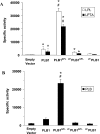
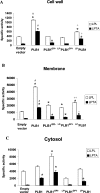

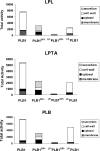
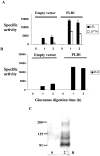
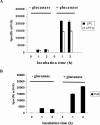
Similar articles
-
N-linked glycosylation sites affect secretion of cryptococcal phospholipase B1, irrespective of glycosylphosphatidylinositol anchoring.Biochim Biophys Acta. 2006 Oct;1760(10):1569-79. doi: 10.1016/j.bbagen.2006.07.002. Epub 2006 Jul 13. Biochim Biophys Acta. 2006. PMID: 16919392
-
Cell wall-linked cryptococcal phospholipase B1 is a source of secreted enzyme and a determinant of cell wall integrity.J Biol Chem. 2007 Dec 28;282(52):37508-14. doi: 10.1074/jbc.M707913200. Epub 2007 Oct 18. J Biol Chem. 2007. PMID: 17947228
-
Lipid rafts in Cryptococcus neoformans concentrate the virulence determinants phospholipase B1 and Cu/Zn superoxide dismutase.Eukaryot Cell. 2006 Mar;5(3):488-98. doi: 10.1128/EC.5.3.488-498.2006. Eukaryot Cell. 2006. PMID: 16524904 Free PMC article.
-
GPI-AP release in cellular, developmental, and reproductive biology.J Lipid Res. 2016 Apr;57(4):538-45. doi: 10.1194/jlr.R063032. Epub 2015 Nov 22. J Lipid Res. 2016. PMID: 26593072 Free PMC article. Review.
-
Transport and metabolism of glycerophosphodiesters produced through phospholipid deacylation.Biochim Biophys Acta. 2007 Mar;1771(3):337-42. doi: 10.1016/j.bbalip.2006.04.013. Epub 2006 May 6. Biochim Biophys Acta. 2007. PMID: 16781190 Review.
Cited by
-
Mechanisms and Virulence Factors of Cryptococcus neoformans Dissemination to the Central Nervous System.J Fungi (Basel). 2024 Aug 17;10(8):586. doi: 10.3390/jof10080586. J Fungi (Basel). 2024. PMID: 39194911 Free PMC article. Review.
-
In vitro synthesis of phospholipids with yeast phospholipase B, a phospholipid deacylating enzyme.Biotechnol Rep (Amst). 2018 Apr 4;18:e00250. doi: 10.1016/j.btre.2018.e00250. eCollection 2018 Jun. Biotechnol Rep (Amst). 2018. PMID: 29876301 Free PMC article.
-
Unravelling secretion in Cryptococcus neoformans: more than one way to skin a cat.Mycopathologia. 2012 Jun;173(5-6):407-18. doi: 10.1007/s11046-011-9468-9. Epub 2011 Sep 6. Mycopathologia. 2012. PMID: 21898146 Review.
-
Unique motifs identify PIG-A proteins from glycosyltransferases of the GT4 family.BMC Evol Biol. 2008 Jun 4;8:168. doi: 10.1186/1471-2148-8-168. BMC Evol Biol. 2008. PMID: 18522757 Free PMC article.
-
A xylosylphosphotransferase of Cryptococcus neoformans acts in protein O-glycan synthesis.J Biol Chem. 2011 Jul 29;286(30):26888-99. doi: 10.1074/jbc.M111.262162. Epub 2011 May 23. J Biol Chem. 2011. PMID: 21606487 Free PMC article.
References
-
- Cox G. M., McDade H. C., Chen S. C. A., Tucker S. C., Gottfredsson M., Wright L. C., Sorrell T. C., Leidich S. D., Casadevall A., Ghannoum M. A., et al. Extracellular phospholipase activity is a virulence factor for Cryptococcus neoformans. Mol. Microbiol. 2001;39:166–175. - PubMed
-
- Leidich S. D., Ibrahim A. S., Fu Y., Koul A., Jessup C., Vitullo J., Fonzi W., Mirbod F., Nakashima S., Nozawa Y., et al. Cloning and disruption of caPLB1, a phospholipase B gene involved in the pathogenicity of Candida albicans. J. Biol. Chem. 1998;273:26078–26086. - PubMed
Publication types
MeSH terms
Substances
Grants and funding
LinkOut - more resources
Full Text Sources
Molecular Biology Databases

